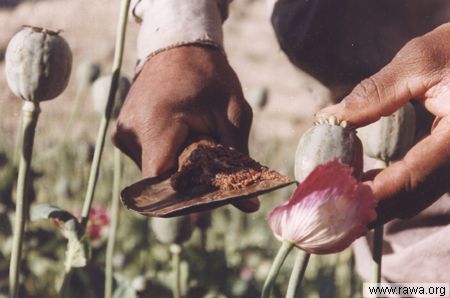Drug addiction on rise with Afghan kids
UN Office on Drugs and Crime found nearly 1 million addicts in this nation of about 30 million people, including 60,000 children under age 15
 "Some cabinet ministers in Afghanistan are deeply implicated in the drugs trade"
"Some cabinet ministers in Afghanistan are deeply implicated in the drugs trade"The Telegraph (UK), February 5, 2006
KABUL - Farida's son inherited her drug addiction in the womb, and drank her opium-laced breast milk. And when he cried and fussed, she calmed him with specks of opium diluted in tea.
This is the hidden face of addiction in Afghanistan — parents spreading drug use in the confines of their homes. All four of Farida's children got high from her husband's secondhand heroin smoke and from the opium she fed them.
She blames a neighbor at the refugee camp where they lived in Pakistan for introducing her husband to drugs. Her husband later advised her to take opium for her cough and aches.
"My husband was on the wrong path, and I followed him because he is my companion," the 28-year-old woman said, nursing her skinny youngest son, 2-year-old Amir Shah. "I didn't know it was bad."
Afghanistan is the world's leading producer of opium and heroin, exporting drugs to Asia, the Middle East, Europe and the United States. But the scale of domestic drug abuse has only recently become apparent.
The first nationwide survey on drug use, conducted last year by the Ministry of Counter Narcotics and U.N. Office on Drugs and Crime, found nearly 1 million addicts in this nation of about 30 million people, including 60,000 children under age 15.
Drugs of choice range from hashish, opium and heroin to pharmaceutical medicines. An estimated 5,000 children are addicted to opiates, and the remainder take cough syrup and other drugs, the survey found. The actual numbers are probably much higher, especially for children and women, the report said.
Nyamat [a former intelligence agent] and an Afghan trafficker singled out Gen. Mohammed Daoud, a former warlord who is Afghanistan's deputy interior minister in charge of the anti-drug effort.
The Kunduz trafficker said he wasn't worried. He counts Daoud as one of his connections. Late in the summer of 2003, he said, Daoud helped him retrieve heroin worth $200,000 that had been seized at the Salang Tunnel
"When one person starts using drugs, the whole family is addicted," says Dr. Tariq Suliman, director of the Nejat drug rehabilitation center where Farida received treatment.
The Ministry of Counter Narcotics has opened clinics and drug centers, but addiction is on the rise in the impoverished war-ravaged country as drug production has spiraled, making narcotics of increasing purity more available.
Opium production rose 49 percent this year to 6,700 tons — enough to make about 670 tons of heroin. That's more than 90 percent of the world's supply and more than the world's addicts consume in a year.
"When the poppy cultivation increases, the number of addicts also increases," said Gen. Khodaidad, deputy minister for policy and coordination in the Ministry of Counter Narcotics. "The addicts — the 920,000 people — this number is increasing day by day."
Along the snowy footpath to Farida's one-room house in Kabul, a social worker pointed out several women — opium addicts treated since the Nejat center opened in 2002 after the ouster of the Taliban regime.
Because there has been little drug education in Afghanistan, many people appear ignorant of the risks of addicting children and the social problems it brings.
Farida, who like many Afghans has only one name, recounted how she and her husband sold their belongings to pay for drugs. One day, her uncle had to fend off a rich man who came to her house to buy her sons.
"He said, 'I have six daughters, but I have no sons. Why do you need sons? You are a drug addict,'" recalled Farida. She spoke in her tiny home built of mud and straw, where her children huddled around a portable gas stove, warming their dusty feet and hands.
With help from the Nejat center, Farida said she and her children weaned themselves off opium in a month, using an over-the-counter analgesic for pain and vitamins to build strength. She said she and her children have not used drugs for about a year and a half.
Elsewhere in Kabul, Maraban Shah and his 6-year-old son, Said Amidullah, were at the newly opened Zendagi-e-Nawin — or New Life — rehabilitation home, recovering from opium addictions picked up in their remote village in Badakhshan province.
The boy was born addicted and was prone to crying, his father said.
"My wife would give him opium behind my back, and he would sleep... If he didn't get it, he would yell and throw a tantrum," Maraban Shah said, sitting with his son on their bed in the rehabilitation home. "One of our relatives taught her to do that — they gave her bad advice."
The mother remains in Badakhshan, addicted to opium. The boy is now chubby and healthy, with rosy cheeks from the winter chill. He sat quietly listening to his father, only interrupting once to say: "Let's bring mommy here for treatment."
[RAWA Homepage] [More reports from Afghanistan] [RAWA Photo Gallery]
http://www.rawa.org